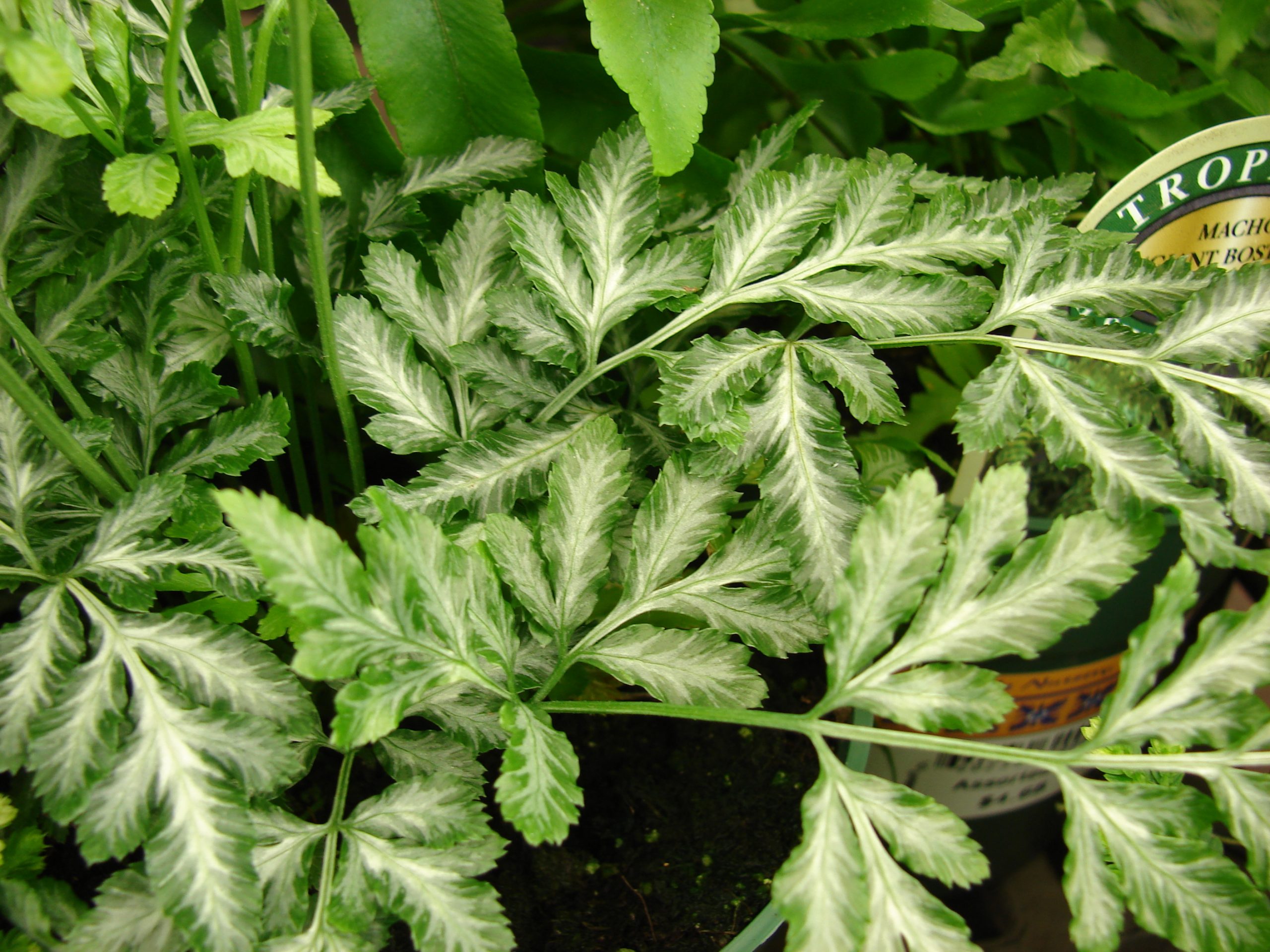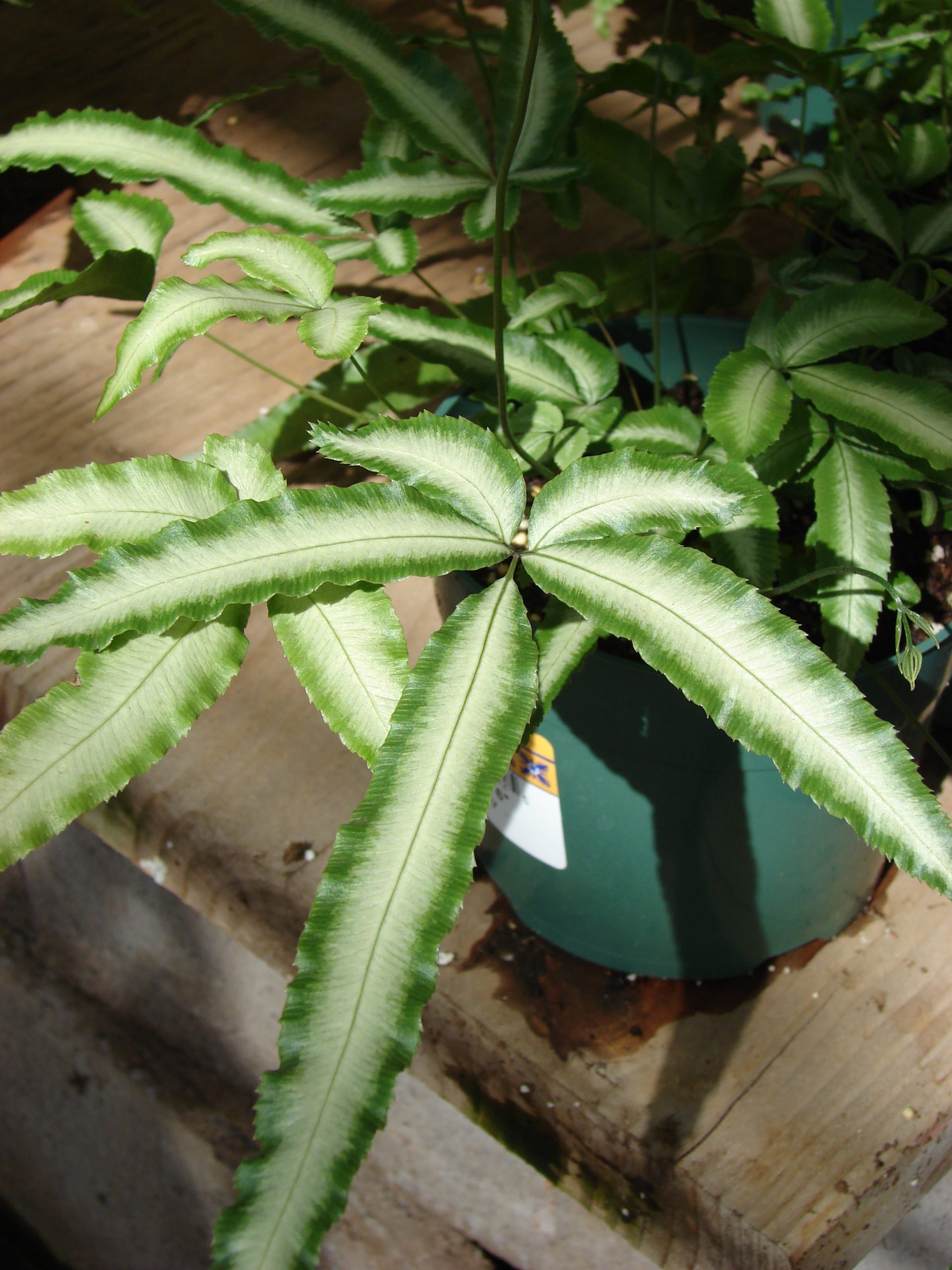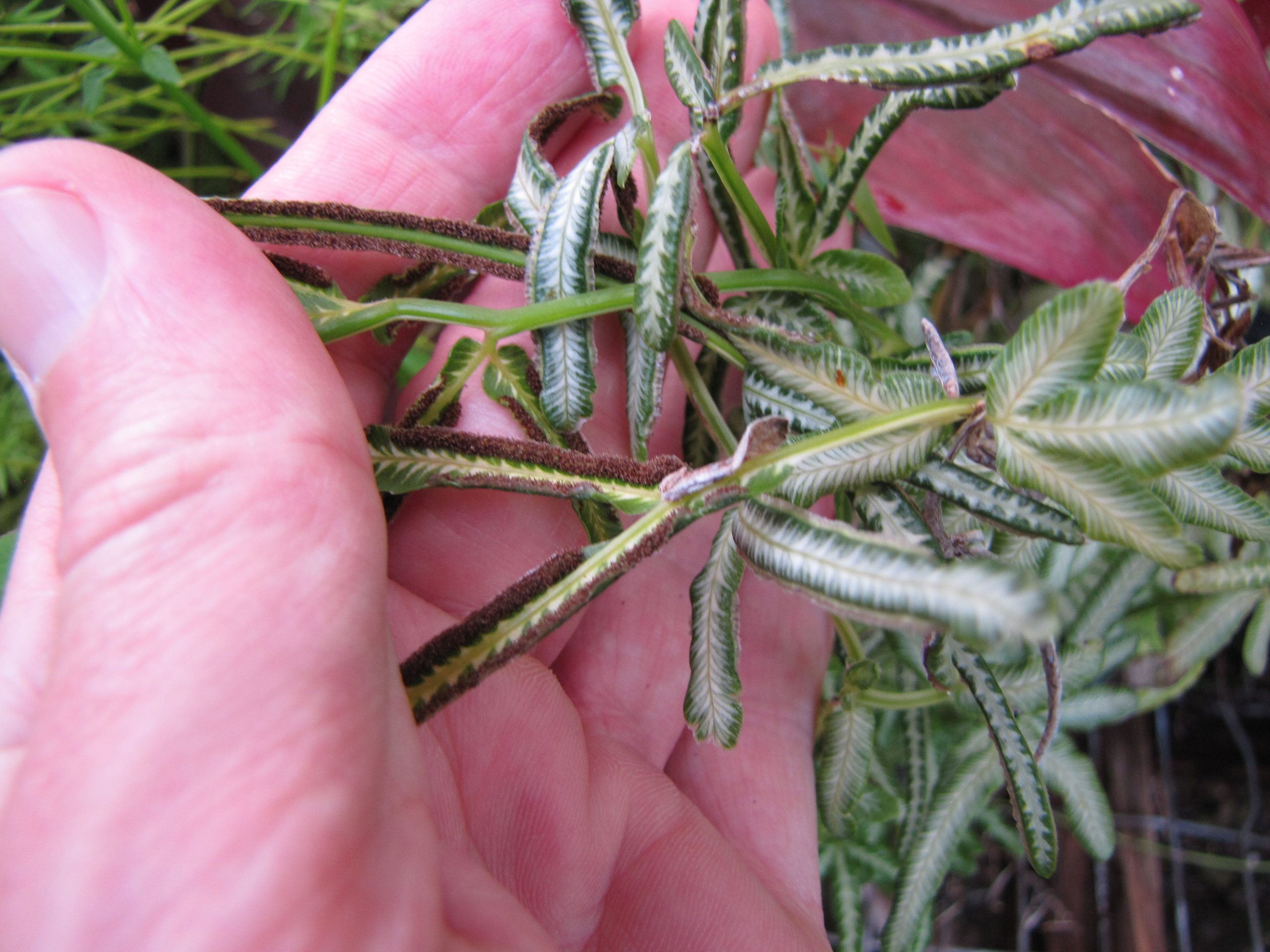HousePlantJoy is supported by our audience. When you purchase through one of our links, we may earn a small affiliate commission. As an Amazon Associate I earn from qualifying purchases. Your cost is not affected.
==================
Hey there, plant lovers! Are you seeking a unique, eye-catching houseplant to spruce your living space? I’d like to introduce you to the Silver Lace Fern houseplant. This delightful houseplant hails from the lush tropical regions of Asia and Africa.
Meet the Silver Lace Fern Houseplant
Picture this: intricate, silver-green fronds that add a touch of elegance to any room they’re in. Yes, that’s the Silver Lace Fern for you! This beauty might seem delicate and requires a bit of TLC, but it’s well worth the effort. Imagine it dangling in a hanging basket. Its fronds are cascading like a waterfall of green and silver.
Forest & Kim Starr, CC BY 3.0 <https://creativecommons.org/licenses/by/3.0>, via Wikimedia Commons
Don’t worry if you’re new to plant parenthood. Even beginners can grow a Silver Lace Fern houseplant successfully. With a bit of attention to detail and the right conditions, it’ll thrive. It’s not fussy, but it enjoys well-draining, humus-rich soil and at least six hours of bright, indirect sunlight daily.
In this article, we’re going on a deep dive into the world of the Silver Lace Fern. We’ll cover everything from the right soil mix to the perfect watering schedule and even how to propagate it. Whether you’re experienced or starting, there’s something here for everyone. I think you should stick around. Let’s learn more about this fascinating Silver Lace Fern houseplant together! Enjoy reading!
Origin of the Silver Lace Fern Houseplant
Alright, friends, let’s take a step back in time and embark on a journey to the roots of the Silver Lace Fern. Can you guess where this delicate beauty first sprouted? You’d have to think tropical, think lush landscapes. That’s right – the Silver Lace Fern comes from the vibrant tropical regions of Asia and Africa.
The Silver Lace Fern’s history is as captivating as its silver-green fronds. It’s a member of the Pteris genus, a group known for its tough, resilient nature despite its delicate appearance. Imagine these ferns gracing the understory of thick forests. Their shiny fronds glint under dappled sunlight.
Here’s a fun fact for you. In many cultures, the Silver Lace Fern was considered a symbol of sincerity and integrity. Their enduring strength makes them a metaphor for resilience.
So, if you welcome a Silver Lace Fern houseplant into your home, you’re adding a piece of natural art. Also, you’ll have a plant with a rich backstory. Isn’t that something to share with your friends the next time they admire your Silver Lace Fern?
Our next section’ll explore the ideal conditions to help this beautiful plant thrive in your home. Don’t go away. There’s more exciting info about your soon-to-be favorite Silver Lace Fern houseplant!
Ideal Conditions for Growth
Growing Silver Lace Ferns can be a rewarding experience. But, to ensure that your plant thrives, you need to provide it with the right growing conditions. Here are some of the ideal conditions for growing Silver Lace Ferns:
-
Light Requirements
Silver Lace Ferns prefer bright, indirect light. Direct sunlight can scorch the leaves. Too little light can make the plant become leggy and weak. You can place your plant in a north or east-facing window or use a sheer curtain to filter the light. If you notice that the leaves are becoming yellow, it could be a sign that the plant is getting too much light.
-
Temperature Preferences
Silver Lace Ferns prefer warm temperatures between 65-80°F (18-26°C). They are sensitive to cold drafts. So avoid putting them near doors or windows that are opened. If the temperature dips under 60°F (15°C), the plant may start to suffer.
-
Humidity Needs
Silver Lace Ferns need high humidity levels to thrive. Ideally, the humidity should be between 70-80%. If the air is too dry, the leaves may turn brown and crispy. You can elevate the humidity levels by using a humidifier. Placing a tray of water near the plant or misting the leaves with water is also effective.
In terms of soil, Silver Lace Ferns prefer well-draining, humus-rich, medium moisture soil. The soil pH levels should be between 5.6 and 7. The soil should not stay soggy as it will kill the plant.
Planting and Repotting Silver Lace Fern Houseplant
When it comes to planting and repotting Silver Lace Ferns, there are a few things to keep in mind. Here are some tips and guidelines to follow:
Forest & Kim Starr, CC BY 3.0 <https://creativecommons.org/licenses/by/3.0>, via Wikimedia Commons
-
Soil Mix
Silver Lace Ferns require a well-draining, humus-rich soil mix with medium moisture. A good soil mix for this plant should have a pH level between 5.6 and 7. The soil should not stay soggy as it can result in root rot. And it can cause the plant to die. A mixture of sand, peat moss, and perlite can be a good combination for the Silver Lace Fern.
-
Pot Selection
When selecting a pot for your Silver Lace Fern, choose a pot that is slightly larger than the current pot. The pot should have good drainage holes to avoid waterlogging. A plastic or ceramic pot can work well for this plant.
-
Repotting Process
Silver Lace Ferns should be repotted every 1-2 years to ensure that the plant has enough space to grow. The best time to repot the plant is in the spring when it is growing actively.
To repot the plant, remove it from its current pot and loosen the roots. Remove any dead or damaged roots. Place the plant in the new pot and fill it with the soil mix, leaving about an inch of space at the top. Water the plant and place it in a bright, indirect light.
Watering and Fertilizing
-
Watering Schedule
Silver Lace Ferns prefer to be kept consistently moist but not waterlogged. It is important not to let the soil dry out completely, as this can cause the fronds to wilt and brown. However, overwatering can also be detrimental to the plant’s health, as it can lead to root rot.
To determine when to water your Silver Lace Fern, check the top inch of soil. It is time to water it if it feels dry when you touch it. During the growing season (spring & summer), you may need to water your fern once or twice a week. When the plant is inactive in the fall and winter, you can water it once every two weeks.
Forest & Kim Starr, CC BY 3.0 US <https://creativecommons.org/licenses/by/3.0/us/deed.en>, via Wikimedia Commons
-
Fertilizer Type and Frequency
Silver Lace Ferns benefit from regular fertilization to encourage healthy growth. Use a balanced, water-soluble fertilizer. During the growing season, you should dilute it to half-strength every two to three weeks. It is important not to over-fertilize, as this can cause the tips of the fronds to turn brown.
When selecting a fertilizer, look for one formulated explicitly for ferns. Don’t use fertilizers that are high in nitrogen. This can cause the fronds to grow quickly but may result in weaker stems and leaves.
Pruning and Propagation
-
Pruning Tips
Pruning Silver Lace Fern is simple and easy. It is important to remove any dead or yellowing fronds to keep the plant healthy. Use a pair of scissors or sharp pruners to snip off the dead fronds. Wait until all the fronds have died back before pruning a deciduous fern. Then grasp all the dead fronds at once and lop them off just above the ground. Make sure not to cut off the new growth as it comes in.
Silver Lace Ferns can also benefit from regular grooming. So they can maintain their shape and appearance. Remove any brown or yellowing leaves or fronds to keep the plant looking neat and healthy. You can also trim back any fronds that are overgrown or touching the ground.
-
Propagation Methods
Silver Lace Ferns can be propagated through spores or division. Propagation through spores is a bit more difficult and time-consuming. But it can be a fun and rewarding process. To propagate through spores, collect the spores from the underside of mature fronds. Then, you can place them in a plastic bag. Seal the bag and keep it in a warm, humid place until the spores germinate. Once the spores have germinated, transfer them to a pot with a suitable growing medium.
Propagation through division is a more straightforward method. To propagate through division, remove the plant from its pot. And you can gently separate the root ball into two or more sections. Make sure each section has a healthy root system and a few fronds. Plant each section in a separate pot with fresh potting soil and water thoroughly.
Potential Problems
When it comes to Silver Lace Ferns, there are a few potential problems that owners should be aware of. These plants are relatively low-maintenance. But they can still fall prey to common pests and diseases.
-
Common Pests
Silver Lace Ferns are susceptible to a few different types of pests. These include spider mites, mealybugs, and scale insects. These pests can cause damage to the leaves and stems of the plant. Thus, it leads to discoloration and wilting.
To prevent these, keeping the plant in a clean and well-ventilated area is essential. Please check out the plant for signs of infestation. These can be webbing or small insects on the leaves. If you notice an infestation, you can use a natural insecticide. You can also wipe the leaves down with a damp cloth.
-
Disease Issues
In addition to pests, Silver Lace Ferns can also be susceptible to several diseases. One common issue is root rot, which can occur if the plant is overwatered or the soil needs to drain correctly. Root rot symptoms include stunted growth, yellowing leaves, and a mushy base.
To prevent root rot, use well-draining soil and avoid over-watering the plant. If you notice signs of root rot, you may need to repot the plant in fresh soil and trim away any damaged roots.
Another disease issue that can affect Silver Lace Ferns is leaf spot. A fungal infection causes this. Symptoms of leaf spots include brown or black spots on the leaves and yellowing and wilting. To prevent leaf spots, keep the plant in a well-ventilated area. You should also avoid getting the leaves wet when watering. If you notice signs of a leaf spot, you can use a fungicide to treat the infection.
With proper care, your Silver Lace Fern should thrive and remain healthy. By keeping an eye out for common pests and diseases, you can catch any issues early. And you’ll be able to take steps to prevent them from causing lasting damage.
Wrapping It Up
And there you have it, folks! Wrapping things up, our dear Silver Lace Fern truly is a spectacle to behold. It can inject a sense of elegance into any room, a living piece of art waving gently as you pass by. Yes, it might need a bit of extra attention, but boy, the rewards are worth it!
Picture your Silver Lace Fern houseplant happily basking in its favorite conditions. It’s humming a sweet tune of gratitude for the perfect humidity you provide. A quick spritz of water here, a nice spot near a humidifier there, and you’ve got a thrilled fern on your hands.
Let’s not forget about the soil. Remember, it loves that well-draining, humus-rich stuff under its roots. It’s kind of like the plant’s favorite dessert – who could resist? And be careful not to overwater. Too much of a good thing can make your Silver Lace Fern sulk, leading to root problems.
When all’s said and done. If you’re on the lookout for a houseplant that’ll turn heads and make you smile, the Silver Lace Fern is your best bet. A little love a touch of care, and you’ll have a thriving, radiant Silver Lace Fern houseplant. It’ll be the envy of all your friends.
Thank you for joining us on this journey, exploring all the ins and outs of Silver Lace Fern care. Ready to take the plunge? Your future fern can’t wait to meet you!
FAQs
How do I care for my silver lace fern?
Silver lace ferns prefer well-draining soil. This is kept moist but not waterlogged. They also thrive in high-humidity environments. So misting the leaves regularly or placing a tray of water nearby can be helpful. Additionally, it’s important to avoid letting the soil dry out completely. You also need to fertilize the plant every 2-3 months with a balanced fertilizer.
Can silver lace fern be grown indoors?
Yes, silver lace ferns are commonly grown indoors as houseplants. They can thrive in a variety of indoor environments. But they should receive adequate light and moisture.
What is the ideal light for silver lace fern?
Silver lace ferns prefer bright, indirect light or filtered sunlight. Placing them near a north or west-facing window can provide the optimal amount of light. Direct sunlight can scorch the leaves. Too little light can cause the bright variegation to fade.
How big does silver lace fern grow?
Silver lace ferns typically grow to be 1-2 feet in height and spread up to 2-3 feet wide. However, the size can depend on the conditions in which the plant is grown.
Is silver lace fern toxic to pets?
Silver lace ferns are non-toxic to pets, making them a safe option for households with cats or dogs.
What are the best ways to propagate silver lace fern?
Silver lace ferns can be propagated through spores or by division. To propagate through spores, allow the plant to produce spores on the undersides of the leaves. Then collect and sow them in a separate container. To propagate by division, gently remove the plant from its pot. Separate the root ball into smaller sections, each with its own set of fronds.
Dive into the Enchanting World of Ferns!
Discover the most fascinating ferns and houseplants, including the Silver Lace Fern houseplant! Join us on Facebook, Instagram, and Twitter for beautiful photos, plant care tips, and a community that celebrates the joy of indoor gardening.
Facebook: https://www.facebook.com/houseplantjoyblog
Instagram: http://instagram.com/houseplantjoy20
Twitter: https://twitter.com/HouseplantJoy
Let’s nurture our green spaces together!
Read More
More Interesting Links










